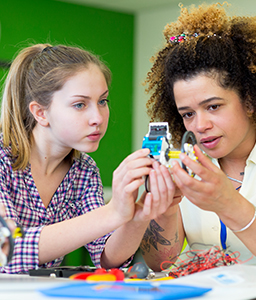Guide to Supporting STEAM and STEM Learning for PTOs and PTAs

Boosting student learning in the areas of science, technology, engineering, and math—STEM—has long been a priority at many schools. More recently, educators and policymakers have stressed adding elements of art and design (a combined approach known as STEAM) to challenge students to think creatively to solve problems, as well as expanding STEM education opportunities at all grade levels.
PTOs and PTAs can play a substantial role in promoting and supporting STEM and STEAM at their schools. This guide to supporting STEM learning for PTOs and PTAs is a must-read for parent groups that want to do just that.
What’s Covered in the Guide to Supporting STEM Learning
Ways To Support STEAM Education
In the push to improve skills in STEM subjects, many schools have added a new element—art and design—and have moved from STEM to STEAM. This relatively new initiative challenges students to use creative thinking and ingenuity to solve real-world problems.
5 Awesome STEAM Events
Mini profiles of actual events from school parent groups, including an Earth Day celebration, a week of science demos, and a tech take-apart night.
Teaching Gardens: Hands-on STEM Learning
Teaching gardens not only provide hands-on learning in an outdoor setting but also offer a variety of other corresponding lessons like composting, gauging weather, plotting and graphing, and nutrition that span the entire curriculum.
18 Ideas for Science Enrichment
Hands-on STEM events and science activities that groups can adapt to their schools.
A Community STEM Effort
When Weatherstone Elementary in Cary, N.C., was designated as a science, technology, engineering, and math school, the PTA organized monthly STEM Fridays and a STEM Expo.
A Year of STEAM
It’s always a good time to encourage kids’ interest in STEAM subjects! Consider scheduling your event during a national observance.
PLUS:
Tips for finding local STEAM experts, a roundup of STEM and STEAM children’s books, and downloadable instructions for a make-your-own-kaleidoscope activity.
Why STEM and STEAM Learning Matter
In the push to improve skills in science, technology, engineering, and mathematics, many schools and educators have added the concept of art and design to the curriculum. This move from STEM to STEAM challenges students to use creative thinking and ingenuity to solve real-world problems. This is especially important because jobs of the future will increasingly rely on workers with a technical background plus creative thinking skills.
Some STEAM advocates believe that the art component serves as an on-ramp to STEM subjects for underrepresented students (women and minorities) as well as students who don’t see themselves as mathematicians or engineers. The push to engage students in technical fields isn’t just a matter of learning the curriculum; it’s about preparing students for the job market they’ll face after graduation. Advocates say linking art education to these more technical fields teaches the type of risk-taking, ingenuity, and problem-solving that employers will need in the future.
The United States already has an increased need for qualified employees for STEM jobs, and the trend is expected to continue. According to the U.S. Department of Commerce, STEM job growth from 2005 to 2015 was six times faster than non-STEM job growth during the same time period. And the Education Commission of the States estimates that between 2017 and 2027, STEM jobs will grow by 13 percent, compared with only 9 percent for non-STEM roles.
In addition, women are underrepresented in STEM fields. According to Million Women Mentors, an international initiative to connect women to science and technology fields, only 26 percent of STEM workers are female; and while 20 percent of engineering graduates are women, they make up only 11 percent of working engineering professionals.
Researchers have also pointed out how important it is to engage students in scientific fields at an early age. A report in the journal Science suggested that exposing students to science topics in elementary or middle school could result in more students aspiring to earn a college degree in a STEM field.
Still have questions? Call us at 800-644-3561; we’re here to help.










